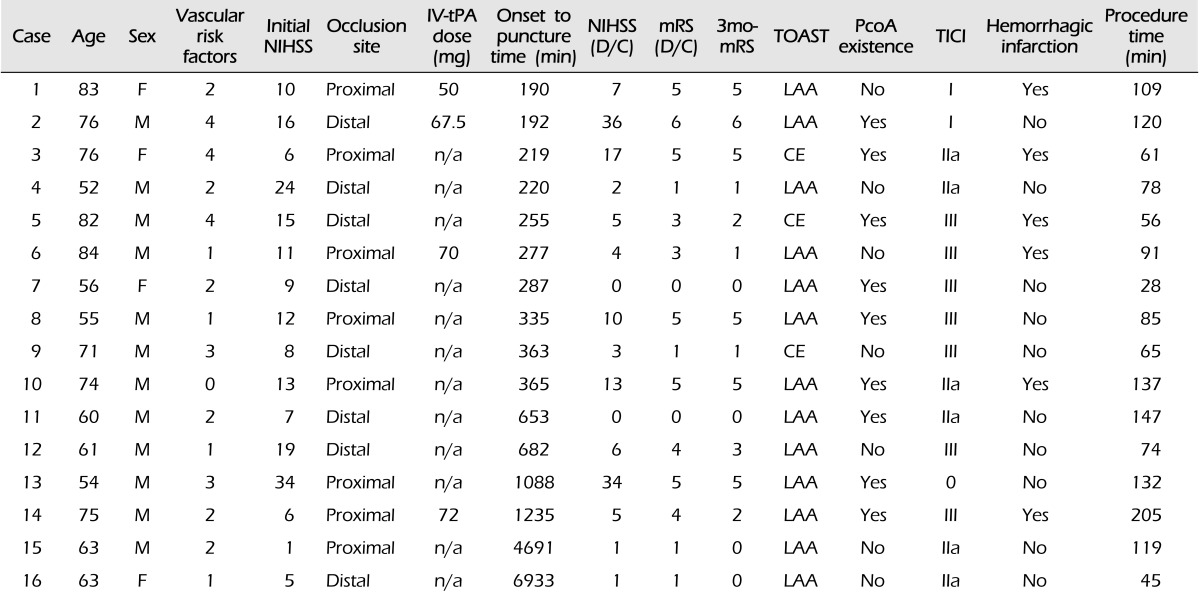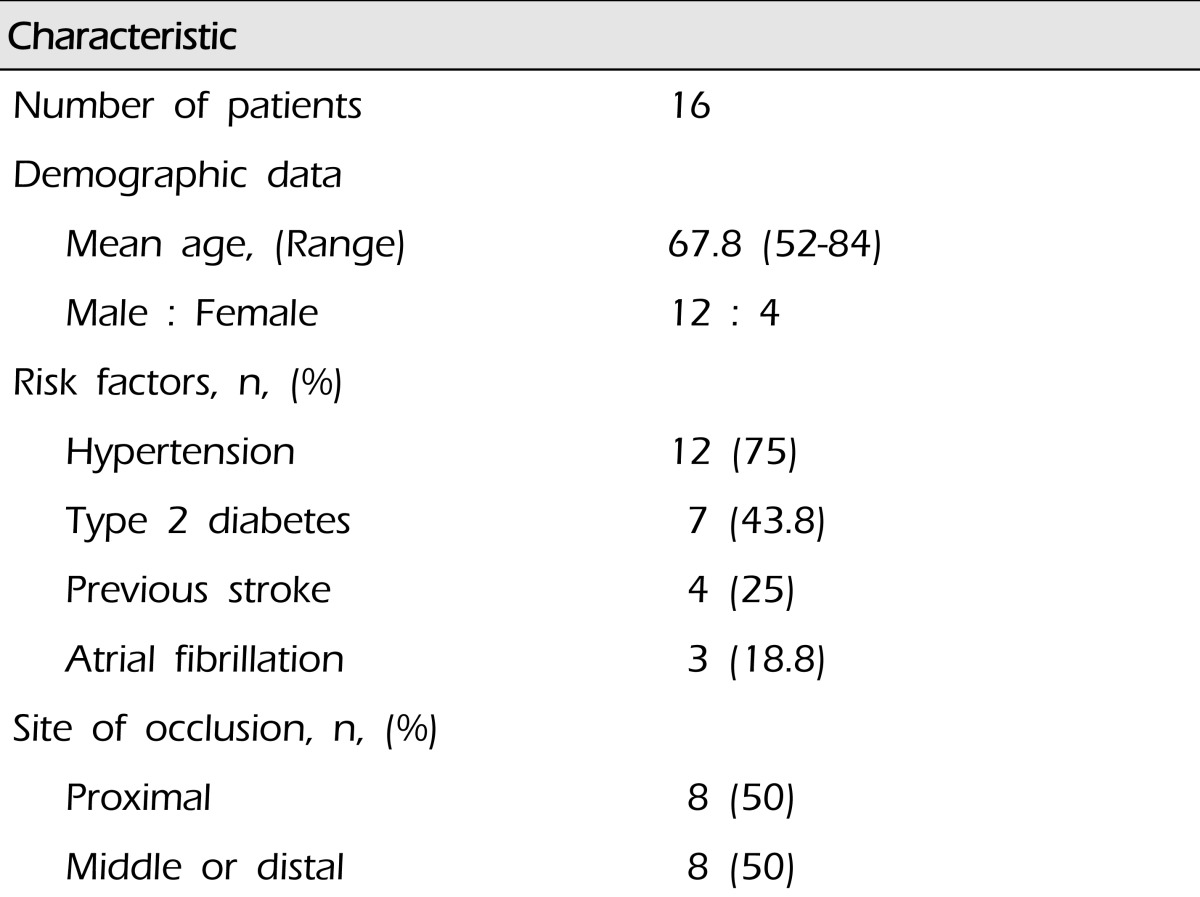1. Andersson T, Kuntze Soderqvist A, Soderman M, Holmin S, Wahlgren N, et al. Mechanical thrombectomy as the primary treatment for acute basilar artery occlusion: Experience from 5 years of practice. J Neurointerv Surg. 2013; 5. 5(3):221–225. PMID:
22434906.
2. Bergui M, Stura G, Daniele D, Cerrato P, Berardino M, Bradac GB. Mechanical thrombolysis in ischemic stroke attributable to basilar artery occlusion as first-line treatment. Stroke. 2006; 1. 37(1):145–150. PMID:
16339473.

3. Chandra RV, Law CP, Yan B, Dowling RJ, Mitchell PJ. Glasgow coma scale does not predict outcome post-intra-arterial treatment for basilar artery thrombosis. AJNR Am J Neuroradiol. 2011; 3. 32(3):576–580. PMID:
21349965.

4. Clarencon F, Blanc R, Gallas S, Hosseini H, Gaston A. Thrombectomy for acute basilar artery occlusion by using double Merci retriever devices and bilateral temporary vertebral artery flow reversal. Technical note. J Neurosurg. 2009; 7. 111(1):53–56. PMID:
19249927.
5. Cross DT 3rd, Moran CJ, Akins PT, Angtuaco EE, Derdeyn CP, Diringer MN. Collateral circulation and outcome after basilar artery thrombolysis. AJNR Am J Neuroradiol. 1998; 9. 19(8):1557–1563. PMID:
9763394.
6. Grigoriadis S, Gomori JM, Grigoriadis N, Cohen JE. Clinically successful late recanalization of basilar artery occlusion in childhood: What are the odds? Case report and review of the literature. J Neurol Sci. 2007; 9. 260(1-2):256–260. PMID:
17482211.
7. Kashiwagi J, Kiyosue H, Hori Y, Okahara M, Tanoue S, Sagara Y, et al. Endovascular recanalization of acute intracranial vertebrobasilar artery occlusion using local fibrinolysis and additional balloon angioplasty. Neuroradiology. 2010; 5. 52(5):361–370. PMID:
20119683.

8. Lee CY, Ryu CW, Koh JS, Kim GK. Late spontaneous recanalization of chronic middle cerebral artery occlusion. Neurointervention. 2012; 9. 7(2):113–116. PMID:
22970421.

9. Lindsberg PJ, Mattle HP. Therapy of basilar artery occlusion: A systematic analysis comparing intra-arterial and intravenous thrombolysis. Stroke. 2006; 3. 37(3):922–928. PMID:
16439705.
10. Mattle HP, Arnold M, Lindsberg PJ, Schonewille WJ, Schroth G. Basilar artery occlusion. Lancet Neurol. 2011; 11. 10(11):1002–1014. PMID:
22014435.

11. Noufal M, Schmidley JW, Erdem E, Keyrouz SG. Basilar artery occlusion treated with mechanical thrombectomy beyond eight hours with successful recanalization and good functional outcomes. Cerebrovasc Dis. 2009; 27(6):614–615. PMID:
19439931.

12. Penumbra Pivotal Stroke Trial Investigators. The penumbra pivotal stroke trial: Safety and effectiveness of a new generation of mechanical devices for clot removal in intracranial large vessel occlusive disease. Stroke. 2009; 8. 40(8):2761–2768. PMID:
19590057.
13. Lindsberg PJ, Soinne L, Tatlisumak T, Roine RO, Kallela M, Happola O, et al. Long-term outcome after intravenous thrombolysis of basilar artery occlusion. JAMA. 2004; 10. 292(15):1862–1866. PMID:
15494584.

14. Pfefferkorn T, Holtmannspotter M, Schmidt C, Bender A, Pfister HW, Straube A, et al. Drip, ship, and retrieve: Cooperative recanalization therapy in acute basilar artery occlusion. Stroke. 2010; 4. 41(4):722–726. PMID:
20150550.
15. Pfefferkorn T, Mayer TE, Opherk C, Peters N, Straube A, Pfister HW, et al. Staged escalation therapy in acute basilar artery occlusion: Intravenous thrombolysis and on-demand consecutive endovascular mechanical thrombectomy: Preliminary experience in 16 patients. Stroke. 2008; 5. 39(5):1496–1500. PMID:
18323481.
16. Roth C, Mielke A, Siekmann R, Ferbert A. First experiences with a new device for mechanical thrombectomy in acute basilar artery occlusion. Cerebrovasc Dis. 2011; 32(1):28–34. PMID:
21576940.

17. Smith WS. Intra-arterial thrombolytic therapy for acute basilar occlusion: Pro. Stroke. 2007; 2. 38(2 Suppl):701–703. PMID:
17261720.
18. Smith WS, Sung G, Saver J, Budzik R, Duckwiler G, Liebeskind DS, et al. Mechanical thrombectomy for acute ischemic stroke: Final results of the Multi MERCI trial. Stroke. 2008; 4. 39(4):1205–1212. PMID:
18309168.
19. Vahedi K, Hofmeijer J, Juettler E, Vicaut E, George B, Algra A, et al. Early decompressive surgery in malignant infarction of the middle cerebral artery: A pooled analysis of three randomised controlled trials. Lancet Neurol. 2007; 3. 6(3):215–222. PMID:
17303527.

20. Voetsch B, DeWitt LD, Pessin MS, Caplan LR. Basilar artery occlusive disease in the New England Medical Center Posterior Circulation Registry. Arch Neurol. 2004; 4. 61(4):496–504. PMID:
15096396.

21. Yu W, Kostanian V, Fisher M. Endovascular recanalization of basilar artery occlusion 80 days after symptom onset. Stroke. 2007; 4. 38(4):1387–1389. PMID:
17322092.








 PDF
PDF ePub
ePub Citation
Citation Print
Print





 XML Download
XML Download